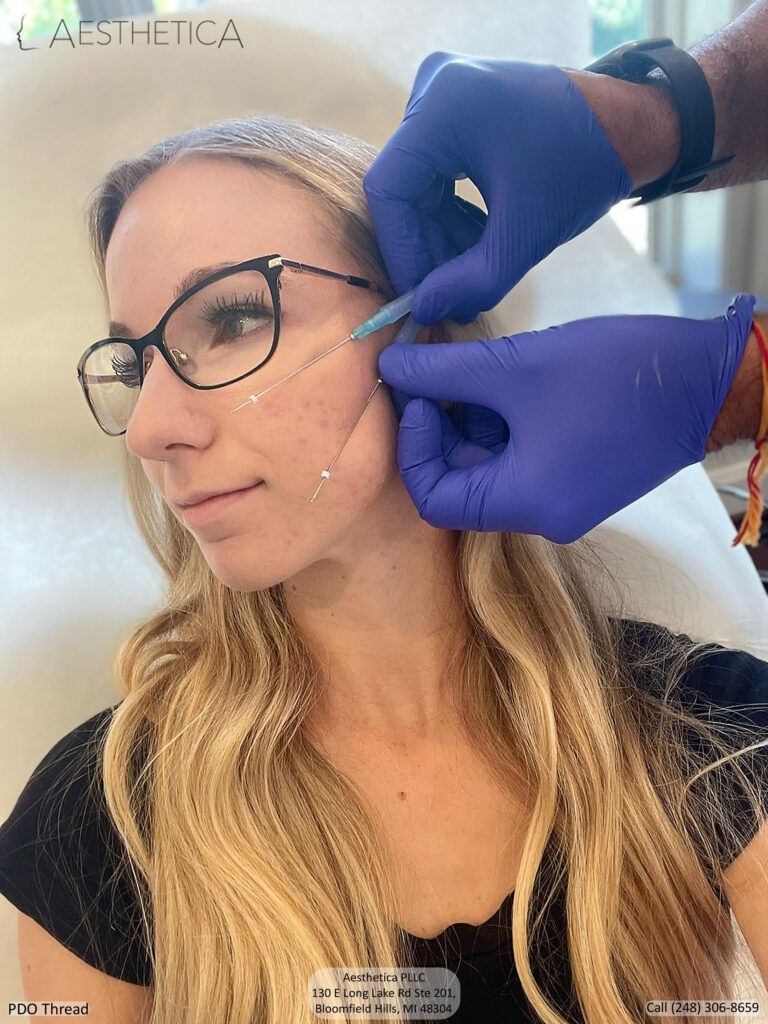(248) 648-3766
- About
- Treatments
- Locations
- Results
- Gift Cards
- Shop
- Blog
- Book Now
- Grover Health

PDO threads are an effective and low-risk procedure for facial rejuvenation by lifting sagging skin on your face. However, a known side effect of the treatment is puckering or dimpling-when the skin in the treated area is wrinkled, forming dimples near the threads’ location. This is usually alarming as it’s noticeable and may look like the treatment isn’t producing any results.
So how do you fix PDO threads puckered at the injection site? Puckering is a very common side effect that lasts up to 2 days or 2 weeks after the procedure as PDO threads will dissolve into the skin after it’s stitched in. Rest and minimal facial movement after the procedure will help ease puckering. Ensure your medical provider is equipped with the right PDO threads and proper procedures to prevent puckering.
Aesthetica can assist you with all your beauty needs, helping you achieve your maximum beauty and aesthetic potential. Call or contact us today to learn more about our cosmetic services.
The PDO thread lift procedure involves inserting a biodegradable suture made of polydioxanone to lift the treated area and promote collagen production as the skin absorbs it. As the threads are dissolvable, there is a lower to no risk of severe side effects such as bruising, scarring, and bleeding compared to using permanent threads. Puckering and dimpling, however, are common symptoms of thread lifts.
Puckering after the PDO thread lift is due to the threads pulling on the skin after they have been inserted. In the case of PDO Threads, this will only last for two weeks at most because by then the threads will have been assimilated into your skin. More often than not, letting the skin rest unbothered will help the face lifting process as the skin incorporates the threads into its tissues. With enough time, the sunken skin will be replaced by natural-looking volume.
Severe cases of puckering where the thread is visible on the face or it’s sticking out of the face is a complication due to poor technique, improper placement, or extremely excessive facial movement. Dire cases of post-procedure thread lifting may require suture removal to prevent any further discomfort or internal damage to the face.

There are numerous factors that can lengthen or shorten the amount and duration of puckering in the skin after PDO Theard. Here are steps you can take before a PDO thread lift to strengthen your skin, making it resistant to long periods of puckering.
The best thing to do after observing puckering in the treated area is to wait it out. Puckering and dimpling is not unusual side effect but a documented and well-known reaction of the skin after the recent insertion of PDO threads. However, it can be bothersome to see the skin continue to sag and wrinkle even if it's temporary.
Don’t schedule or go to any events for the first two days after the procedure so that you may focus on resting your face. It will also provide ample time to deal with other visual side effects such as bruising and swelling. If the puckering and dimpling persist after a week or two, consult a doctor.
These vices are known to have adverse effects on the skin. Alcohol consumption will narrow the blood vessels making them prone to bruising and reducing the rate of oxygen and nutrients delivered to the parts of the body.
It can also dehydrate the skin, prolonging other side effects and lengthening the recovery period. Smoking has similar results including wrinkling the skin due to the heat, smoke, and through facial movement from sucking in the cigarette and it damages collagen production.
These substances may also influence the anesthetic step and the overall efficacy of the treatment. These activities should be avoided after the procedure as well to ensure a stable recovery process.
Unrelieved or intense puckering after a week of the treatment may be due to the material and positioning of the threads. In these cases, the thread lift can be eased with other procedures such as bipolar radiofrequency to tighten the skin and unravel the thread or through the use of a microcannula to directly unwind it.
Consult your medical provider to ascertain what material is used in the threads and if it is from a certified manufacturer. Additionally, whether the puckering is temporary or persistent, it is important to have a follow-up appointment so that the doctor may check for any irregularities after the treatment.
The visible side effects of surgical facelifts and other face contouring procedures usually appear after a day or two after the treatment. In the case of PDO threads, the downtime for these side effects is minimal as the sutures begin to dissolve in the skin after they have been applied to the face.
These are the ways to properly identify puckering which is a common effect in the procedure. Should there be any discrepancies or the puckering and dimpling continues to persist after 2 weeks, consult a doctor.
The patient sees no immediate effect after a few hours or a day after the PDO thread lifting. Instead, dimples, wrinkles, and sagging begin to appear near the treated area along with redness, swelling, or bruising. The amount of puckering may intensify depending on the level of skin laxity. To ease the swelling and pain, the patient is advised to take paracetamol and incorporate Vitamin C and zinc in their diet.
Signs of regular dimpling include:
After the side effects have subsided, any puckering or dimpling may also begin to ease. Instead of indention, dimples, and continued wrinkling in or near the affected area, there will be skin tightening and added volume in the cheeks. This signals that collagen production has begun in the treatment area as the sutures have been absorbed by the facial skin of the patient.
Visual indicators of a successful PDO thread lift include:
At this stage, should the puckering continue accompanied by infection, facial stiffness, and redness, suture removal may be required to ease any further discomfort and facial disfigurement. Another indicator of severe cases of dimpling are visible threads in the cheeks.
Though puckering is an unpleasant side effect of thread lift procedures, there’s a shorter recovery period to it compared to other procedures like plastic surgery. There are numerous effective ways to ease it and other side effects so that the face properly adjusts to the PDO threads.
A cold compress can help ease any painful or uncomfortable bruising and swelling in the treated area. It may help pause any further wrinkling and puckering as it tightens the outer layers of the skin. As the bruising and swelling lessen, the skin may be able to focus on absorbing the PDO threads as well as giving you peace of mind to not pay any more attention to the treated area.
Aggressive facial movements will disturb the sutures placed in your face, leading to longer puckering. Avoid moving or nudging your face for up to two days after the procedure. This also includes washing and scrubbing the face, applying makeup, and using moisturizers such as lotions and facial creams. Also, refrain from making exaggerated facial expressions for a week or two.
It’s also for this reason that intense exercising is disallowed for two weeks after a thread lift-these activities also raise the blood pressure in the head and agitate the face, increasing the chances for bruising and swelling. Furthermore, don’t plan a dental treatment until two weeks after the procedure or until all and any side effects have subsided.
Letting the threads settle in your face is the best way to ease puckering, especially a day or two after the procedure. This can also be done in your sleep by lying down on your back. Resting on your side or on your chest will force you to place pressure on one side of your face in order to breathe.
The extra strain on either side of the face may result in swelling in the morning and puckering on one side if done repeatedly. Sleep in this position for a week after the thread lifting to allow the sutures to rest in the face without any motion or pressure for a long period of time.

Puckering is a common side effect after PDO Thread Lift. While it may be distressing as it looks like the procedure isn't working, it can be alleviated through home remedies and proper aftercare steps. The best way to prevent puckering and other undesirable side effects is to receive your PDO thread procedure from a medical spa you can trust.
At Aesthetica, our team of aestheticians knows every step of the thread lift procedure and its result on the skin, ensuring that no side effects and complications will get in the way of the recovery process. Contact us today to receive natural and reliable treatment for your skin.
Aesthetica can assist you with all your beauty needs, helping you achieve your maximum beauty and aesthetic potential. Call or contact us today to learn more about our cosmetic services.